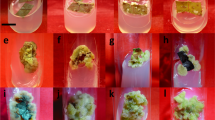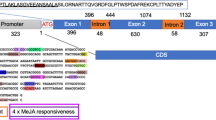Abstract
Bax, a mammalian pro-apoptotic member of the Bcl-2 family, triggers hypersensitive reactions when expressed in plants. To investigate the effects of Bax on the biosynthesis of clinically important natural products in plant cells, we generate transgenic Catharanthus roseus cells overexpressing a mouse Bax protein under the β-estradiol-inducible promoter. The expression of Bax in transgenic Catharanthus roseus cells is highly dependent on β-estradiol concentrations applied. Contents of catharanthine and total terpenoid indole alkaloid of the transgenic cells treated with 30 μmol/L β-estradiol are 5.0-and 5.5-fold of the control cells. Northern and Western blotting results show that expression of mammalian Bax induces transcriptional activation of Tdc and Str, two key genes in terpenoid indole alkaloid biosynthetic pathway of Catharanthus roseus cells, and stimulates the accumulation of defense-related protein PR1 in the cells, showing that the mouse Bax triggers the defense responses of Catharanthus roseus cells and activates the terpenoid indole alkaloid biosynthetic pathway. Thus, our data suggest that the mammalian Bax might be a potential regulatory factor for secondary metabolite biosynthesis in plant cells and imply a new secondary metabolic engineering strategy for enhancing the metabolic flux to natural products by activating the whole biosynthetic pathway rather than by engineering the single structural genes within the pathways.
Similar content being viewed by others
References
Verpoorte R, Van der Heijden R, Van Gulik W M, et al. In: Brossi A, ed. The Alkaloids, Vol 40. New York: Academic Press, 1991. 2–187
Roberts S C, Shuler M L. Large-scale plant cell culture. Curr Op Biotechnol, 1997, 8: 154–159
Yu S W, Ou-Yang G C. The material basis of plant pathogenic resistance. In: Yu S W, Tang Z C, eds. Plant Physiology and Molecular Biology (in Chinese). Beijing: Science Press, 1999. 770–783
Ebel J, Scheel D. Elicitor recognition and signal transduction. In: Boller T, Meins F, eds. Genes Involved in Plant Defense. New York: Springer-Verlag, 1992. 183–205
Ciddi V, Srinivasan V, Shuler M L. Elicitation of Taxus sp. cell cultures for production of taxol. Biotechnol Lett, 1995, 17: 1343–1346
Li C, Yuan Y J, Ma Z H, et al. Changes of physiological state of suspension cultures of Taxus chinensis var. mairei induced by oligosarchride. J Chem Indus Engineer (in Chinese), 2002, 53(11): 1133–1138
Buchanan B B, Gurissem W, Jones R L. Biochemistry and Molecular Biology of Plants, 1st ed. American Society of Plant Physiologists, 2000. 1250–1316
Baek D, Nam J, Koo Y D, et al. Bax-induced cell death of Arabidopsis is meditated through reactive oxygen-dependent and-independent processes. Plant Mol Biol, 2004, 56: 15–27
Lacomme S, Cruz S S. Bax-induced cell death in tobacco is similar to the hypersensitive response. Proc Natl Acad Sci USA, 1999, 96: 7956–7961
Murashige T, Skoog F A A. A revised medium for rapid growth and bioassay with tobacco tissue cultures. Physiol Plant, 1962, 15: 473–479
Clark M S. Plant Molecular Biology—A Laboratory Manual. 1st ed. Berlin Heidelberg: Springer-Verlag, 1979. 305–340
Cruz S S, Chapman S, Roberts S C, et al. Assembly and movement of a plant virus carrying a green fluorescent protein overcoat. Proc Natl Acad Sci USA, 1996, 93: 6286–6290
Menke F L, Parchmann S, Mueller MJ, et al. Involvement of the octadecanoid pathway and protein phosphorylation in fungal elicitor-induced expression of terpenoid indole alkaloid biosynthetic genes in Catharanthus roseus. Plant Physiol, 1999, 19: 1289–1296
De Luca V, Marineau C, Brisson N. Molecular cloning and analysis of cDNA encoding a plant tryptophan decarboxylase: Comparison with animal dopa decarboxylases. Proc Natl Acad Sci USA, 1989, 86: 2582–2586
Pasquali G, Goddijn O J, de Waal A, et al. Coordinated regulation of two indole alkaloid biosynthetic genes from Catharanthus roseus by auxin and elicitors. Plant Mol Biol, 1992, 18: 1121–1131
Xu M J, Dong J F. Nitric oxide stimulates indole alkaloid production in Catharanthus roseus cell suspension cultures through a protein kinase-dependent signal pathway. Enzyme Microb Technol, 2005, 37: 49–53
Zuo J R, Niu Q W, Chua N H. Technical advance: An estrogen receptor-based transactivator XVE mediates highly inducible gene expression in transgenic plants. Plant J, 2000, 24: 265–274
Canel C, Lopes-Cardoso M I, Whitmer S, et al. Effects of over-expression of strictosidine synthase and tryptophan decarboxylase on alkaloid production by cell cultures of Catharanthus roseus. Planta, 1998, 205: 414–419
Kutchan T M. Alkaloid biosynthesis [mdash]: The basis for metabolic engineering of medicinal plants. Plant Cell, 1995, 7: 1059–1070
Meijer A H, Verpoorte R, Hoge J H C. Regulation of enzymes and genes involved in terpenoid indole alkaloid biosynthesis in Catharanthus roseus. J Plant Res, 1993, 3: 145–164
Goddijn O J M, Lohman F P, De Kam R J, et al. Nucleotide sequence of the tryptophan decarboxylase gene of Catharanthus roseus and expression of tdc-gusA gene fusions in Nicotiana tabacum. Mol Gen Genet, 1994, 242: 217–225
Xu M J, Dong J F. Elicitor-induced nitric oxide burst is essential for triggering catharanthine synthesis in Catharanthus roseus suspension cells. Appl Microbiol Biotechnol, 2005, 67: 40–44
Linthorst H J M. Pathogenesis-related proteins of plants. Crit Rev Plant Sci, 1991, 10: 123–150
Simonen M, Keller H, Heim J. The BH3 domain of Bax is sufficient for interaction of Bax with itself and with other family members and it is required for induction of apoptosis. Eur J Biochem, 1997, 249: 85–91
Zha H, Aime-Sempe C, Sato T, et al. Proapoptotic protein Bax heterodimerizes with Bcl-2 and homodimerizes with Bax via a novel domain (BH3) distinct from BH1 and BH2. J Biol Chem, 1997, 271: 7440–7444
Kiwai-Yamada M, Jin L, Yoshinage K, et al. Bax-induced plant cell death can be down-regulated by overexpression of Arabidopsis Bax Inhibitor-1 (AtBI-1). Proc Natl Acad Sci USA, 2001, 98: 12295–1300
Zhao J, Zhu W, Hu Q. Selection of fungal elicitors to increase indole alkaloid accumulation in Catharanthus roseus suspension cell culture. Enzyme Microb Technol, 2001, 28: 666–672
Xu M J, Dong J, Zhu M Y. Effect of nitric oxide on catharanthine production in Catharanthus roseus suspension cells. Biotechnol Bioeng, 2005, 89: 367–371
Capell T, Christou P. Progress in plant metabolic engineering. Curr Opin Biotechnol, 2004, 15:148–154
Sato F, Hashimoto T, Haciya A, et al. Metabolic engineering of plant alkaloid biosynthesis. Proc Natl Acad Sci USA, 2001, 98: 367–372
Rothe G, Hachiya A, Yamada Y, et al. Alkaloids in plants and root cultures of Atropa belladonna overexpressing putrescine N-methyltransferase. J Exp Bot, 2003, 54(390): 2065–2070
Moyano E, Jouhikainen K, Tammela P, et al. Effect of pmt gene overexpression on tropane alkaloid production in transformed root cultures of Datura metel and Hyoscyamus muticus. J Exp Bot, 2003, 54(381): 203–211
Hahlbrock K, Bednarek P, Ciolkowski I, et al. Non-self recognition, transcriptional reprogramming, and secondary metabolite accumulation during plant/pathogen interactions. Proc Natl Acad Sci USA, 2003, 100s: 14569–14576
Broun P, SomervIlle C. Progress in plant metabolic engineering. Proc Natl Acad Sci USA, 2001, 16: 8925–8927
Bovy A, de Vos R, Kemper M, et al. High-flavonol tomatoes resulting from the heterologous expression of the maize transcription factor genes LC and C1. Plant Cell, 2002, 14(10): 2509–2526
Yu O, Shi J, Hession A O. Metabolic engineering to increase isoflavone biosynthesis in soybean seed. Phytochemistry, 2003, 63: 753–763
Author information
Authors and Affiliations
Corresponding author
Additional information
Supported by the National Natural Science Foundation of China (Grant No. 30572331), the Natural Science Foundation of Zhejiang Province (Grant No. 302785), and the Key Scientific Project of Zhejiang High Education Commission
Rights and permissions
About this article
Cite this article
Xu, M., Dong, J. Enhancing terpenoid indole alkaloid production by inducible expression of mammalian Bax in Catharanthus roseus cells. SCI CHINA SER C 50, 234–241 (2007). https://doi.org/10.1007/s11427-007-0030-4
Received:
Accepted:
Issue Date:
DOI: https://doi.org/10.1007/s11427-007-0030-4




